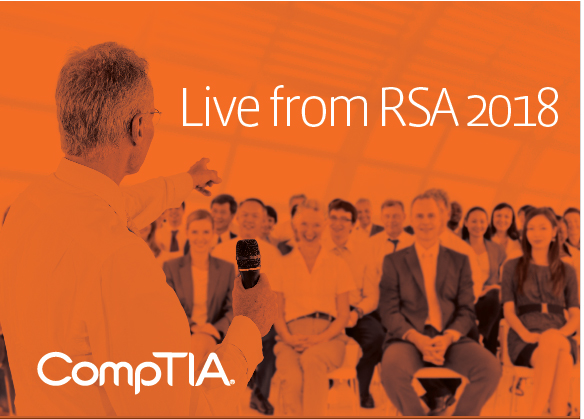 RSA is one of the largest cybersecurity conferences in the world, with hundreds of sessions and thousands of exhibitors across a full week. Because of this, everyone has a unique experience and takes away different things. CompTIA's IT Career News spoke with a few cybersecurity experts to hear more about their key takeaways and a-ha moments from this year’s event.
RSA is one of the largest cybersecurity conferences in the world, with hundreds of sessions and thousands of exhibitors across a full week. Because of this, everyone has a unique experience and takes away different things. CompTIA's IT Career News spoke with a few cybersecurity experts to hear more about their key takeaways and a-ha moments from this year’s event.
Collaboration and Competition
Alex Heid, White Hat Hacker and Chief Research Officer of SecurirtyScorecard
A lot of these companies, ourselves included, are working together on integrations. It’s not necessarily as competitive as it used to be. If there are two companies that do threat intelligence, they may not necessarily be fighting for the same customer. Chances are, the customer’s going to buy both of them, especially if they have components to integrate.
From the standpoint of nerding out on the technology of how all that’s going to work, that’s really interesting. It’s weird watching how open-source community ethics are merging with corporate community ethics, which didn’t really exist before. It’s still very cut-throat – that’s the nature of business – but it’s almost like integrations have to be able to support that to even continue to play the game. I’m looking forward to seeing what type of hybrids are going to spin out of all this once everyone gets a real fix on the full capabilities of everyone’s projects.
Skills Shortage and Endpoint Challenges
AN Ananth, Chief Strategy Officer of Netsurion and Chief Executive Officer of EventTracker
- Skills Shortage: It’s a problem affecting everyone, everywhere. Finding and retaining even one or two skilled people can be hard. There are different ways of addressing the skills shortage, such as co-managed solutions, or in the future, [artificial intelligence].
- The Battle at the Endpoint: No attacker is attacking the well-fortified [headquarters] anymore. You spend a lot of time putting up barriers – moats, alligators in the moat, drawbridges, all of these things. If you do in fact attack, you’ll be found out, you’ll be caught. So, the battle has shifted to the endpoint, staffed by people who aren’t necessarily technical, who can be phished or socially engineered. And once you’re in with a toe hook, you can go somewhere else. The battle has shifted from being the moat in central HQ down to the end users.
- The Proliferation of Endpoints: The number of devices getting on the network is proliferating like crazy because of IoT. Recently a casino had inserted a digital thermometer in one of its fish tanks, and attackers were able to hacked that thermometer, get onto the network and steal the high-roller database. There’s not a difference between consumer and business IoT issues – it’s just an IoT security issue. If you didn’t think security was a thing when adding a device, any device to the network, then guess what? it’s a thing. In 2018, if it’s on the network, it’s a threat.
What to Do with All the Data
Liz Maida, Founder, Chief Executive Officer and Chief Technology Officer of Uplevel Security
The understanding and awareness of the challenges of dealing with security data and the fact that it really is something they want to start looking at and addressing. Thinking about how you start forming a collective response to cybersecurity based upon all this really valuable data that today exists in the analysts heads but isn’t being captured in any format.
I think that cybersecurity has been so siloed. The realization that we need to be thinking about the actual data challenges of all these pieces of infrastructure versus continuing to build siloed solutions. What are you doing with your data, and why are you keeping it? Storing tons of data for compliance purposes when you’re not even using it makes no sense, so there’s problems on both sides – why are you storing it if you don’t need it, and why aren’t you using it?
Response and Automation
Morey Haber, Chief Technology Officer of BeyondTrust
It’s not just about detection and visibility or the traditional buzzwords. There’s a lot of energy around response – doing things proactively and automation that’s coming to the forefront. How do you automatically do something versus actually seeing an event? That automation or that autonomous behavior. I think that’s the biggest thing to take away from RSA this year – we’re trusting our computers more to help us make security decisions, including even stopping people from access.
Diversity
Russ Schrader, Executive Director of the National Cyber Security Alliance
It was very interesting to see how topical everything has been, whether it’s election security, blockchain, AI, there’s a lot here for RSA. I’m also noticing a more diverse attendee population, slowly but surely, and that’s a great thing, and we need to push that kind of diversity in attendance.
Read more from RSA 2018:
- Collaboration and Cybersecurity Culture in the Spotlight at RSA 2018
- Knowledge Is Power: Slaying the Cloud Beasts
Advance your cybersecurity career with the CompTIA Cybersecurity Career Pathway.

